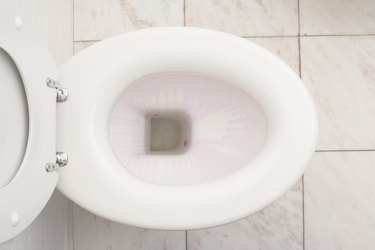Things You'll Need
Ladder
Flashlight
Drain auger
Garden hose
Bucket
Adjustable wrench
Putty knife
New wax ring
Pipe wrench

When washing water down one plumbing fixture's drain causes another plumbing fixture to overflow, a few potential problems could be the cause. If the vent pipes that connect to the various drainpipes in your house have a clog from leafs, twigs or other debris that have fallen down them, the clog throws off the air equilibrium in the pipes causing the drains to behave strangely. A clog in the larger drainpipe the toilet and washing machine connect to can also cause the problem, as well as a major clog in the sewer drain line.
Step 1
Climb onto your house's roof using a ladder and remove any objects on the top of the plumbing vent pipes that are stopping airflow. Shine a flashlight down the plumbing vent pipes coming out of the roof to look for clogs inside the pipes.
Video of the Day
Step 2
Feed a drain auger down any vent pipes that have clogs to push the clogs free. If you cannot reach a clog with the auger, spray water down the pipe with a garden hose to dislodge the clog, stopping once the water flows down the pipe freely.
Step 3
Twist the water supply valve on the wall behind the toilet clockwise until the handle stops, closing the valve and cutting off the water supply to the toilet. Flush the toilet to drain the water out of the tank and bowl.
Step 4
Place a bucket under the water supply line and disconnect it from the water supply valve using an adjustable wrench. Remove the nuts from the bolts in the toilet's base with the adjustable wrench and then pull up on the toilet to unseat it from the floor.
Step 5
Feed a drain auger down the drainpipe in the floor as you spin the crank on the auger clockwise. Stop once you have uncoiled the entire flexible line and then turn the crank counterclockwise as you pull the flexible line out of the drainpipe.
Step 6
Scrape off the old wax ring from the flange using a putty knife, place a new wax ring with the flat side down on the flange, and then replace the toilet. Tighten the nuts on the bolts on the toilet's base until the toilet cannot move in any direction, and then tighten the nut on the water supply line back on the water supply valve.
Step 7
Locate the cleanout caps that sit between your house and the sewer system. If water is flowing out around the closed caps, call a plumber for assistance in removing the clog in the house's sewer drain line. If no water is flowing out, remove the cap from the cleanout using a pipe wrench and look inside the trap. If you see standing water or debris inside the trap, contact a plumber since this also means a clog has formed in the sewer drain line.
Video of the Day